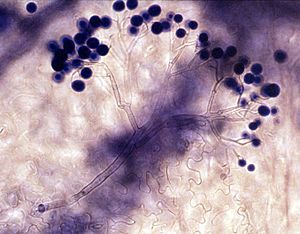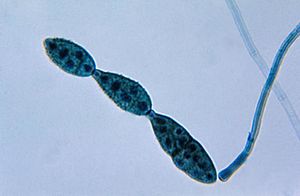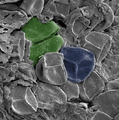Spore facts for kids
Spores are the way fungi and some non-seed plants (ferns and mosses) reproduce. They are also made by bacteria for long-term survival. Some protozoa also make long-term survival spores.
The spores of seed plants are single cells that grow into a pollen grain or the gametophyte inside the ovule. The structure of seeds in higher plants is more complicated than spores. The main 'innovation' of seeds is their nutrition for the developing embryo, which spores do not have.
Fungal spores
Fungi (for example, mushrooms) produce spores, which may be asexual or sexual. The asexual spores have inside them the genetic material to make a whole new organism identical to its parent.
Conidia are asexual, non-motile spores of a fungus; they are also called mitospores due to the way they are generated through the cellular process of mitosis. They are haploid cells genetically identical to the haploid parent, can develop into a new organism if conditions are favorable, and serve in dispersal.
Asexual reproduction in Ascomycetes (the Phylum Ascomycota) is by the formation of conidia, which are borne on specialized stalks called conidiophores. The morphology of these specialized conidiophores is often distinctive of a specific species and can therefore be used in identification of the species.
Bacterial spores
Bacterial spores are extremely resistant. Spores of tetanus and anthrax, for example, can survive in the soil for many years. The origin of these spores was discovered in the 19th century, when a biologist noticed, under the microscope, a small, round, bright body inside bacterial cells. This survived even when the bacteria were boiled for five minutes. This killed the bacteria, but not the spores. They germinated when conditions were right.p186
Plant spores
Plants have alternation of generations. One of the generations is the sporophyte, which produces spores by meiosis, and the other is the gametophyte with produces gametes.
Images for kids
-
Fresh snow partially covers rough-stalked feather-moss (Brachythecium rutabulum), growing on a thinned hybrid black poplar (Populus x canadensis). The last stage of the moss lifecycle is shown, where the sporophytes are visible before dispersion of their spores: the calyptra (1) is still attached to the capsule (3). The tops of the gametophytes (2) can be discerned as well. Inset shows the surrounding, black poplars growing on sandy loam on the bank of a kolk, with the detail area marked.
-
Fossil trilete spores (blue) and a spore tetrad (green) of Late Silurian origin
-
Tricolpate pollen of Ricinus
-
Spores of the moss Bartramia ithyphylla. (microscopic view, 400x)
-
Spores and elaters from a horsetail. (Equisetum, microscopic view)
-
Spore clusters, formed inside sporangia of the slime mold Reticularia olivacea, from pine forests of eastern Ukraine.
See also
 In Spanish: Espora para niños
In Spanish: Espora para niños














